Key Takeaways
- Encourage drawing and coloring to foster creativity and relaxation.
- Facilitate dance sessions to improve physical health and self-expression.
- Engage in crafting projects to enhance focus and fine motor skills.
- Create a happy music playlist to boost mood and reduce anxiety.
- Enjoy warm bubble baths to promote relaxation and mental well-being.
Drawing and Coloring
Engaging children in drawing and coloring activities fosters creativity and self-expression and facilitates the development of essential fine motor skills. These activities allow kids to explore their imaginations, translating their thoughts and emotions onto paper. Beyond the artistic benefits, drawing and coloring are effective self-care practices that promote mental well-being. By focusing on these creative tasks, children can experience reduced stress and anxiety, finding solace in the rhythmic motions of coloring and the freedom of drawing.
Moreover, coloring can be incredibly calming and soothing, aiding kids in emotional regulation. It offers them a structured yet creative outlet to express their feelings verbally. This aspect of art therapy is invaluable, providing a safe space for children to navigate and articulate complex emotions.
Drawing and coloring also foster a sense of accomplishment, boosting self-esteem and confidence. Each completed artwork becomes proof of their efforts and creativity, reinforcing positive self-worth. Encouraging these activities as part of a child’s self-care routine nurtures their artistic abilities. It supports their overall mental and psychological health, making it a valuable addition to their daily lives.
Happy Music Playlist

After nurturing creativity through drawing and coloring, another effective self-care practice for children is creating a happy music playlist. Music can remarkably boost mood and promote positive emotions, making it invaluable for enhancing children’s overall well-being. Children can relax, unwind, and reduce stress by listening to their favorite songs, creating a comforting and joyful environment.
Encouraging children to curate their playlists empowers them to express their preferences and emotions distinctly. This sense of autonomy fosters a deeper connection to their feelings and builds confidence as they choose the music that resonates with them. Moreover, incorporating music into daily routines can transform ordinary moments into joyful experiences, fostering a sense of happiness and relaxation.
A well-chosen playlist can engage children’s senses, providing a sensory-rich experience that enhances their emotional well-being. Whether it’s upbeat tunes that inspire dancing or soothing melodies that calm the mind, the right music can be a powerful self-care tool. For caregivers and educators, supporting children in this endeavor enriches their emotional landscape and contributes to a nurturing and positive environment.
Baking Together
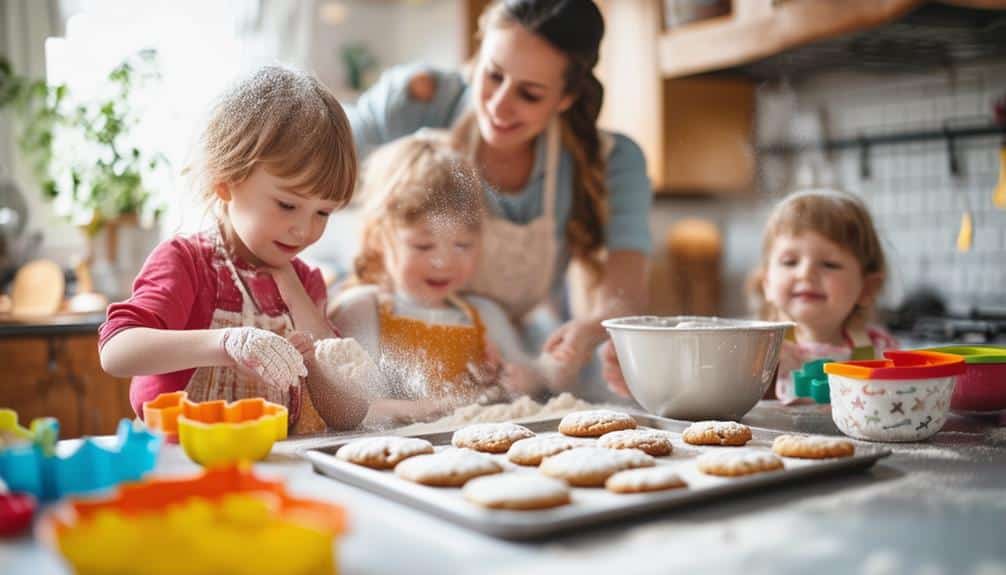
Baking with children offers a delightful opportunity to bond while imparting essential life skills and fostering creativity. This shared activity strengthens family relationships and serves as a practical, hands-on educational experience for kids. The quality time spent in the kitchen enables children to learn valuable skills such as following instructions and precise measurements, forming a foundation for culinary and general life competencies.
The benefits of baking together extend beyond just skill acquisition. Here are three key advantages:
- Creativity and Exploration: Baking encourages children to experiment with different ingredients and flavors, enhancing their creative thinking.
- Sensory and Motor Development: The tactile experience of mixing, kneading, and decorating aids in developing fine motor skills and hand-eye coordination.
- Confidence Boost: Successfully creating and enjoying their baked goods instills a sense of accomplishment and boosts self-esteem.
Investing time in baking together fortifies familial bonds and provides a nurturing environment for children to grow and thrive. The combination of learning and leisure makes baking an ideal self-care activity, enriching the lives of children and their caregivers.
Writing Postcards
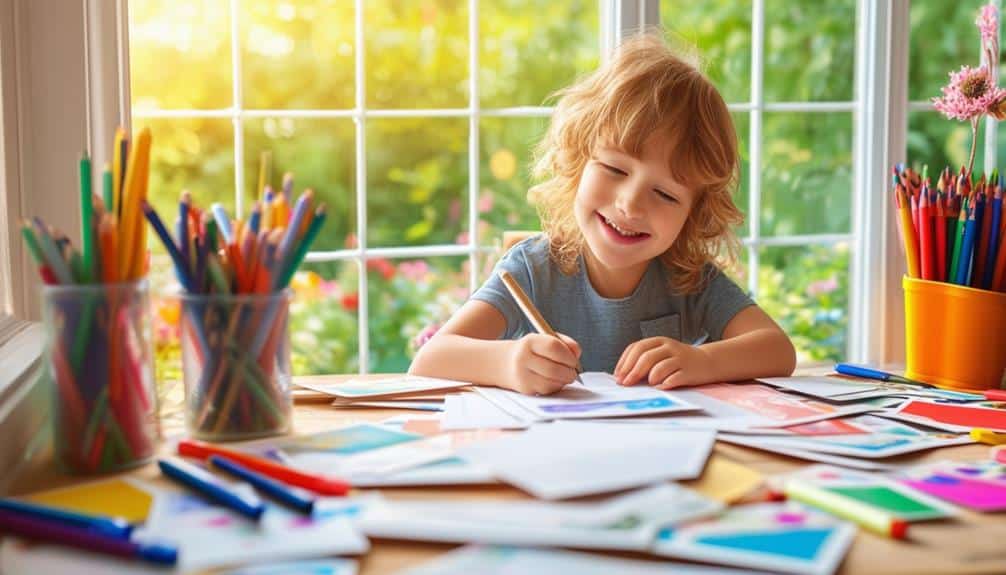
Just as baking together can build essential skills and foster creativity, writing postcards offers another enriching activity that encourages children to express themselves and connect with loved ones. This simple act is a mindful exercise, allowing kids to relax and focus on crafting positive messages. Writing postcards nurtures their creativity and literacy skills and strengthens their sense of connection and gratitude.
The process of creating and sending postcards involves multiple dimensions of skill development and personal growth:
| Activity Aspect | Benefits | Impact on Children |
|---|---|---|
| Writing | Enhances literacy skills | Improved handwriting and grammar |
| Storytelling | Boosts creativity | Nurtures imagination and expression |
| Drawing | Develops artistic skills | Encourages visual communication |
| Sending | Promotes connection | Fosters relationships and empathy |
Writing postcards allows children to share their thoughts and feelings in a tangible, sincere way. This activity cultivates communication skills and offers a meaningful way for kids to show care for others. Moreover, sending a postcard can be a rewarding experience, knowing that the message will bring joy to someone else. By integrating writing postcards into their routine, children can experience a holistic form of self-care that is both enriching and profoundly connecting.
Warm Bubble Baths

Indulging in warm bubble baths can be an excellent way for children to relax and unwind, promoting physical comfort and mental well-being. The soothing warmth of the water creates a serene environment that helps children de-stress after a long day. Incorporating bubble baths into a child’s routine can be a delightful method of encouraging self-care for kids while providing quality time between parents and children.
To maximize the benefits of bath time, consider the following:
- Add Bath Toys: Introducing engaging and safe bath toys can make the experience enjoyable and stimulate a child’s imagination, turning relaxation into a playful activity.
- Use Essential Oils: Adding a few drops of child-safe essential oils, such as lavender or chamomile, can enhance the bath’s calming effects, promoting more profound relaxation and better sleep.
- Create a Routine: Establishing a consistent bathtime routine can help signify the end of the day, aid in the shift to bedtime, and foster a sense of security and consistency.
Nature Walks

Nature walks allow children to explore the outdoors, engage their senses, and foster a deeper connection with the natural world. These excursions are more than just a simple stroll; they are a means to reduce stress and enhance overall mental health. Scientific studies have shown that spending time in nature can significantly improve mood and boost cognitive function in children, leading to a more balanced and focused mind.
Encouraging children to participate in nature walks promotes physical activity, essential for their developing bodies. The simple act of walking through a park, forest, or along a trail allows kids to engage in exercise while breathing in fresh air. This physical activity not only strengthens their muscles but also supports cardiovascular health.
Moreover, nature walks are a gateway to curiosity and learning. Observing various wildlife, plants, and natural elements can spark a child’s imagination and curiosity. This experiential learning fosters a deeper appreciation for the environment and cultivates lifelong habits of mindfulness and observation.
Simple Yoga Poses
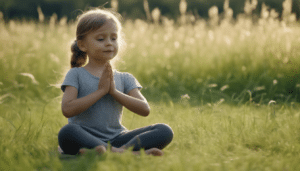
Engaging children in simple yoga poses like downward dog, tree pose, and cat-cow can significantly enhance their flexibility, relaxation, and overall well-being. These child-friendly yoga poses are excellent for developing body awareness, balance, and coordination while effectively reducing stress and anxiety. The simplicity of these exercises allows them to be practiced indoors and outdoors, requiring minimal space and no special equipment.
Encouraging deep breathing during yoga poses can help children calm their minds and focus on the present moment, fostering a sense of peace and mental stability. Regular practice can significantly contribute to their physical health and mental well-being.
To maximize the benefits of yoga poses for children, consider the following tips:
- Create a Routine: Establish a consistent schedule for practicing yoga to build a habit and make it a part of their daily routine.
- Incorporate Fun: Make the sessions enjoyable by introducing playful elements and encouraging creativity in how they perform the poses.
- Promote Deep Breathing: Teach children the importance of deep breathing to enhance relaxation and mental clarity.
Reading Time
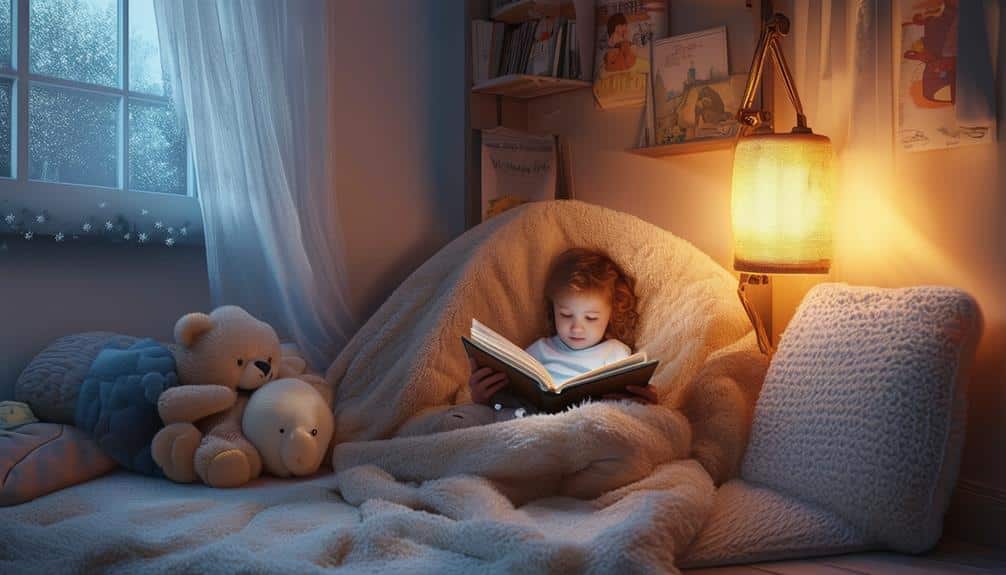
Reading time is essential for children, fostering their language development, cognitive skills, and imagination. Engaging in regular reading sessions helps children build robust language skills by expanding their vocabulary and enhancing comprehension. It also stimulates their mental abilities, encouraging creative thinking and problem-solving.
Moreover, reading time is a valuable bonding experience between children and caregivers. Shared storytelling moments create a nurturing environment that strengthens emotional connections and provides security. This bonding can lay a strong foundation for open communication and trust as children grow.
Reading aloud to children plays a vital role in enhancing their listening skills. It demands their attention and concentration, improving their ability to focus for extended periods. Additionally, these interactions nurture critical thinking as children learn to anticipate story outcomes and understand complex narratives.
Mindful Breathing

Mindful breathing is a simple yet powerful practice that helps children calm their minds, improve concentration, and regulate feelings effectively. By incorporating deep breaths into their daily routines, children can learn to manage stress and reduce anxiety, making it an essential component of self-care activities for kids.
This straightforward technique can be implemented at any time, providing immediate benefits. When teaching mindful breathing, consider the following steps:
- Find a Quiet Space: Encourage children to sit or lie in a peaceful area where they feel safe and comfortable. This helps minimize distractions and allows them to focus on their breathing.
- Guide Their Breathing: Instruct them to take slow, deep breaths through the nose and out through the mouth. Counting to four while inhaling and exhaling can provide a rhythmic structure.
- Focus on Sensations: Ask children to pay attention to how their body feels with each breath—the rise and fall of their chest, the sensation of air entering and leaving their lungs. This mindfulness helps anchor their attention and fosters a sense of calm.
Teaching children mindful breathing empowers them with a valuable tool for self-care and mood regulation. By integrating this practice into their lives, you equip them with a lifelong skill to navigate challenges with resilience and poise.
Gardening Fun
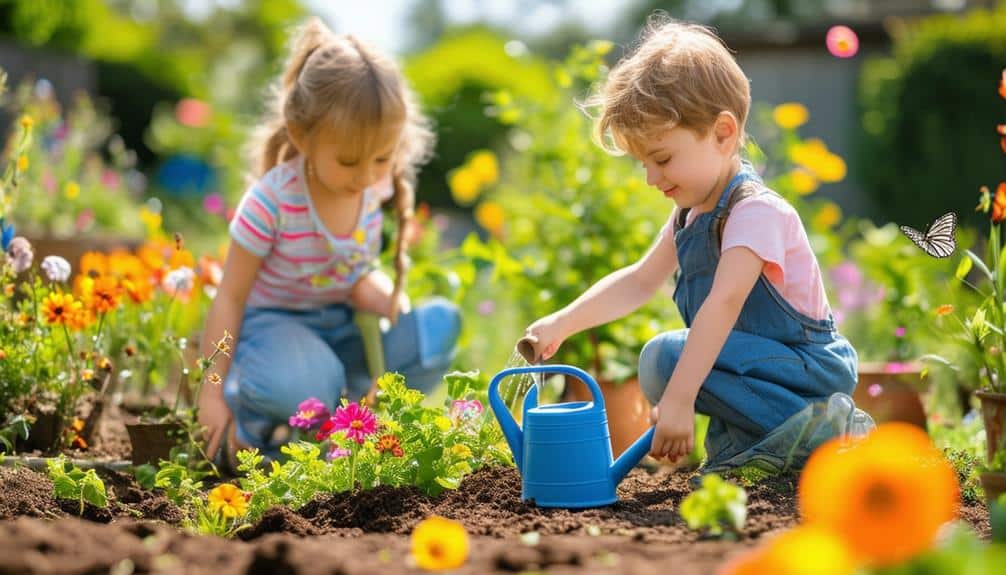
Gardening fun offers a multidimensional learning experience that fosters children’s development and connection to the natural world. Gardening with kids nurtures a sense of responsibility as they learn to care for living things. It also cultivates patience and an appreciation for the environment. This hands-on activity allows children to immerse themselves in outdoor play, promoting physical activity and a connection to nature.
Gardening can significantly boost children’s self-esteem. The sense of accomplishment they feel as they see their plants grow and thrive is invaluable. Moreover, growing fruits, vegetables, or flowers can inspire healthy eating habits, increasing appreciation for fresh produce.
Below is a table highlighting the key benefits of gardening with kids:
| Benefit | Description | Impact |
|---|---|---|
| Responsibility | Learning to care for plants | Enhances sense of duty and care |
| Patience | Understanding the growth process | Builds patience and long-term thinking |
| Outdoor Play | Physical activity in a natural setting | Promotes physical health and well-being |
| Self-Esteem | Accomplishments from successful plant growth | Boosts confidence and self-worth |
| Healthy Habits | Growing and eating fresh produce | Encourages nutritious eating and lifestyle |
Dance Party

Organizing a dance party is an excellent way for kids to engage in physical activity while having fun. Start by choosing upbeat music your child enjoys, and consider inviting friends to join in the experience. Encourage kids to create dance moves, fostering creativity and boosting confidence.
Choose Fun Music
Choosing lively and enjoyable music for a dance party can significantly improve children’s mood and energy. The right tunes can transform an ordinary afternoon into an exhilarating experience, enhancing emotional and physical well-being. Here are three key benefits of selecting the perfect music for a children’s dance party:
- Boost Mood: Upbeat music can lift spirits and create a joyful atmosphere. Whether it’s catchy pop songs or energetic instrumental tracks, the rhythm and melody can immediately spark happiness and reduce stress in children.
- Promote Physical Activity: Dancing to music is a fun form of exercise that encourages kids to move their bodies. This physical activity improves their coordination and motor skills and helps them burn off excess energy positively.
- Enhance Creativity and Self-Expression: Music allows children to explore different rhythms and dance styles, fostering creativity and self-expression. This can be particularly beneficial in building their confidence and encouraging them to express their distinct personalities through movement.
Invite Friends Over
Building on the joy that music brings, inviting friends to a dance party can further amplify the fun and benefits for children. Hosting a dance party encourages social interaction, essential for developing healthy communication skills and fostering positive experiences. When children spend time with friends in a lively and engaging environment, they enjoy the moment and create lasting memories, contributing to their overall well-being.
A dance party offers a distinctive platform for kids to express themselves through movement, which can uplift their mood and boost energy levels. Combining music and dancing allows children to release pent-up energy positively, contributing to their physical and emotional health. Furthermore, such gatherings promote bonding among peers, providing an opportunity for laughter, teamwork, and mutual enjoyment.
Encouraging children to participate in these social gatherings can help them build solid friendships and enhance their social skills. By organizing a dance party, caregivers and parents can create a safe and enjoyable space where kids can thrive. These positive experiences are invaluable for children’s development, making dance parties an excellent self-care strategy.
Create Dance Moves
Encouraging children to create their dance moves enhances their creativity and is essential to their physical development and mental well-being. Dancing provides a fun and dynamic way for kids to release pent-up energy and express themselves. It promotes physical activity, vital for maintaining a healthy lifestyle, and helps improve coordination and motor skills.
Organizing a dance party can be an excellent way for kids to socialize and connect with others, fostering a sense of community and teamwork. Beyond the social benefits, dancing helps children learn to follow a beat, improve their rhythm, and develop musicality. This multifaceted activity offers a range of developmental benefits that contribute to a child’s overall well-being.
Here are three key benefits of encouraging dance moves:
- Physical Activity: Regular dancing helps children stay active, improve cardiovascular health, and build muscle strength.
- Coordination: Learning and creating dance moves enhances motor skills and hand-eye coordination.
- Emotional Expression: Dancing provides an outlet for children to express themselves, helping to boost mood and reduce stress.
Incorporating dance into daily routines can be a simple yet effective way to support children’s physical and mental health.
Crafting Projects
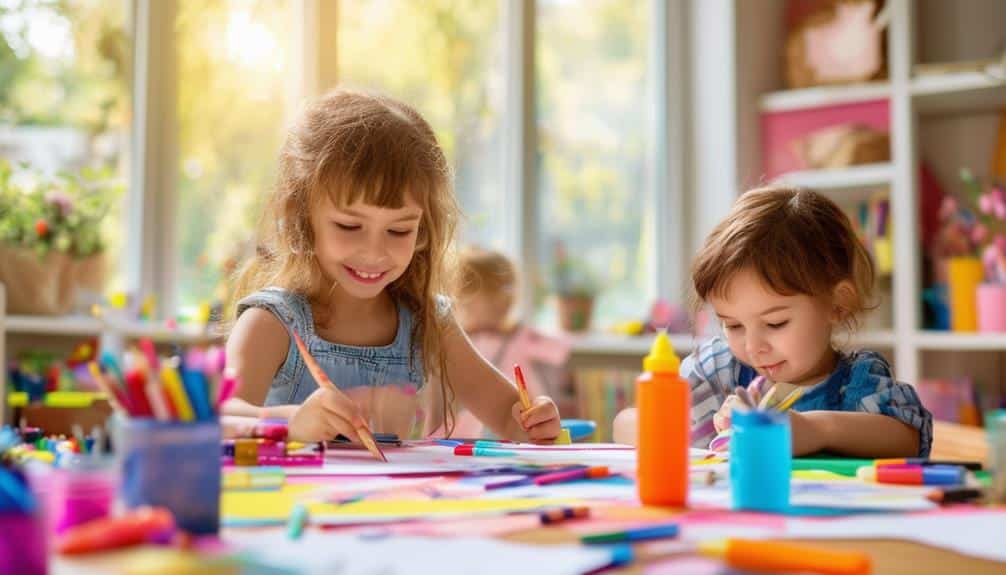
Engaging children in crafting projects nurtures their fine motor skills and enhances their creativity and ability to focus. Crafting projects serve as an excellent medium for self-expression, enabling children to channel their imagination into tangible creations. This process, in turn, fosters a heightened sense of self-esteem as children take pride in their accomplishments.
Manipulating materials—cutting, gluing, or painting—develops talent and strengthens the small muscles in one’s hands, which are essential for writing and tying shoelaces. Moreover, crafting activities requires concentration that helps improve focus, an important skill for academic success and everyday tasks.
Furthermore, DIY crafts offer a distinctive opportunity for children to unwind and relax. The repetitive motions in many crafting activities can be soothing, providing a sense of calm and mindfulness. This makes crafting an ideal self-care practice, especially in today’s fast-paced environment.
Parents and caregivers can facilitate these benefits by providing materials and encouraging experimentation. Simple projects like making friendship bracelets, constructing paper mâché sculptures, or creating homemade greeting cards can be both fun and profoundly developmental. Through crafting, children can discover the joys of creation and the satisfaction of self-expression.
Frequently Asked Questions
How Do I Take Care of Myself as a 10-Year-Old?
Take care of yourself at 10, engage in regular physical activities, maintain good hygiene, express emotions through creative outlets, establish a consistent sleep routine, and explore hobbies. These practices foster overall well-being and individual growth.
How Do I Take Care of Myself as a Kid?
How can you nurture your well-being as a child? Engage in creative and physical activities, establish calming bedtime routines, practice deep breathing, and learn self-care habits. These steps promote independence, relaxation, and overall wellness.
What Is Self-Care for Kids?
Self-care for kids encompasses activities that enhance their physical, psychological, and mental well-being, such as practicing good hygiene, engaging in creative pursuits, and socializing. These practices build healthy habits, resilience, and independence early on.
What Are Some Self-Care Tips for Kids?
For self-care, consider these five pivotal actions: express creativity through art, engage in stimulating physical activities, embrace mindfulness techniques, establish nurturing sleep and nutrition routines, and cultivate meaningful social connections. Each fosters holistic well-being.
Conclusion
Implementing simple self-care ideas for children lays the foundation for a lifetime of mental and physical health. Activities like drawing, listening to their favorite song, and engaging in deep breathing can help reduce stress. These self-care tips foster creativity and relaxation while teaching essential coping skills. Including self-care activities in daily routines ensures children are prepared to handle life’s challenges with resilience.
Incorporating self-care habits into your child’s daily life, such as breathing exercises or jumping jacks, can positively impact their emotional health. Encourage healthy self-care habits by establishing a sleep routine that promotes quality sleep and reduces screen time before bed. These practices support quality sleep and overall mental well-being, helping children manage academic and social pressures more effectively.
Spending quality time with your child on activities like baking a healthy meal or playing a board game can strengthen family bonds and teach valuable self-care skills. Please encourage them to keep a journal to foster gratitude and positive self-talk. Making these self-care strategies a part of everyday life creates a nurturing environment that supports your child’s overall development and well-being.

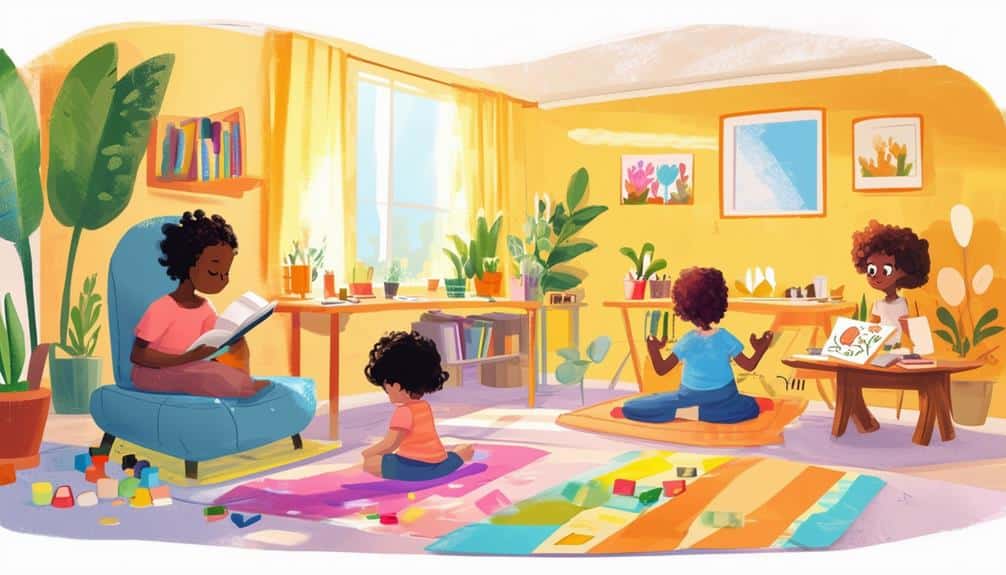
Recent Comments